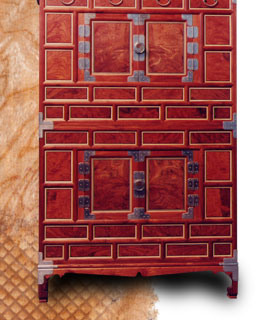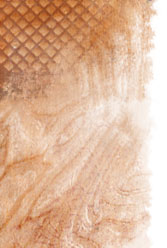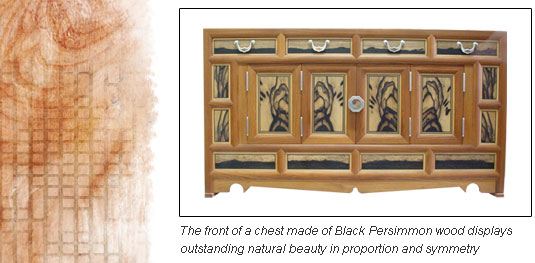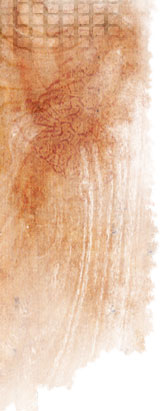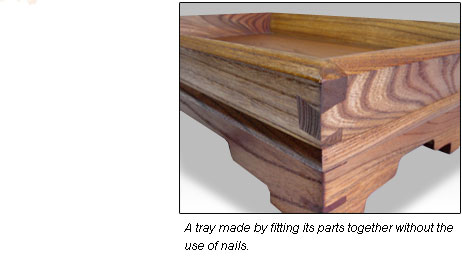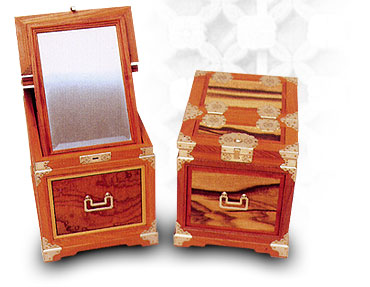 A wonderful piece of Asian style furniture made by Master Seol begins with his outstanding ability A wonderful piece of Asian style furniture made by Master Seol begins with his outstanding ability
 of finding the right wood and his knowledge of how to use it. When he sees a tree standing before him,
of finding the right wood and his knowledge of how to use it. When he sees a tree standing before him,
 his intuition instantly tells him what he should do with it and how the grain of its wood would look. He
his intuition instantly tells him what he should do with it and how the grain of its wood would look. He
 feels that he establishes a close rapport with a tree through the grain of its wood, which, he considers, feels that he establishes a close rapport with a tree through the grain of its wood, which, he considers,
 is the meditation of the tree while it was rooted in the same spot for several hundred years. is the meditation of the tree while it was rooted in the same spot for several hundred years.
 Whilst he is creating a work of art, he gains inspiration by his relationship with the tree and the
Whilst he is creating a work of art, he gains inspiration by his relationship with the tree and the
 function of the furniture he is making. In fact, once a wood is chosen, he brings it to his bedroom
function of the furniture he is making. In fact, once a wood is chosen, he brings it to his bedroom
 and sleeps with it. He says there is a significant difference between the works made of the wood
and sleeps with it. He says there is a significant difference between the works made of the wood
 he has slept with and that of wood he hasn't. You can, he argues, find the most suited function for
he has slept with and that of wood he hasn't. You can, he argues, find the most suited function for
 the wood only after you have heard its voice and know its mind.
the wood only after you have heard its voice and know its mind.
 The first step to making a superb piece of Asian style furniture is to find the right wood. Quality The first step to making a superb piece of Asian style furniture is to find the right wood. Quality
 wood is usually found from trees that are at least 300 years old. The older the tree, the more beautiful
wood is usually found from trees that are at least 300 years old. The older the tree, the more beautiful
 the grain of its wood, and the more firm. Wood from a young tree is inferior to wood from an older
the grain of its wood, and the more firm. Wood from a young tree is inferior to wood from an older
 tree in terms of patterns and hardness, plus it can easily warp. The ensuing step is to cut the tree.
tree in terms of patterns and hardness, plus it can easily warp. The ensuing step is to cut the tree.
 The ideal period for cutting is between October and March because trees harvested during this period
The ideal period for cutting is between October and March because trees harvested during this period
 do not have much sap and thus, do not easily decay.
do not have much sap and thus, do not easily decay.

Next, the tree must be dried in the open air for approximately five to seven years without cutting. This period of time,
during which the trees suffer the onslaught of the elements and the seasons, allows the carpenter to find excellent
wood that doesn't decompose or warp after it is made into furniture; the low-quality woods, thus, are discarded. Also,
wood that is cut before it is properly dried often results in distortion, which makes the task of Asian style furniture-making
very difficult.
When cutting the wood into sections according to their specific uses, the carpenter must take his utmost care to
keep the beauty of the natural wood patterns. For Black Persimmon wood, for instance, the cutting process is
particularly important because the wood is usually used for the furniture's front panels so that the pure exquisiteness of
its distinctive patterns can be viewed by the beholder. Accordingly, the craftsman needs years of experience and
exceptional skills. After cutting, the individual pieces need to be dried for another three to five years in a shaded area
with good air circulation. Drying in this environment is also important to prevent the wood from warping.
 This drying process is followed by a 'design- This drying process is followed by a 'design-
 cutting' procedure, in which the carpenter
cutting' procedure, in which the carpenter
 chooses, prior to cutting, natural patterns
chooses, prior to cutting, natural patterns
 within the dried wood according to the
within the dried wood according to the
 furniture's intended use. If he finds a design
furniture's intended use. If he finds a design
 particularly attractive, he can cut the wood from
particularly attractive, he can cut the wood from
 side to side in order to get two thinner panels
side to side in order to get two thinner panels
 of the same design, which he may use for the
of the same design, which he may use for the
 symmetrical front panels of a chest like the one
symmetrical front panels of a chest like the one
 shown left. Another drying session ensues, shown left. Another drying session ensues,
 this time only lasting about a month in an area
this time only lasting about a month in an area
 devoid of moisture, before the woodworker
devoid of moisture, before the woodworker
 begins the unique process of ssamjil
begins the unique process of ssamjil
 ('covering'). The ssamjil process involves
('covering'). The ssamjil process involves
 creating a single panel by gluing two panels
creating a single panel by gluing two panels
 together. The key here is that one panel should together. The key here is that one panel should
be hard, warp-resistant wood while the other should possess a beautiful natural pattern. By joining the two panels,
the craftsman can procure a panel that is strong enough to withstand distortion while displaying a magnificent design.
For instance, Zelkova wood is loved by Korean furniture makers for the beauty of its patterns, but because it is very soft
wood it needs to be backed by a hard section of Paulownia in order for it to be used in a piece of furniture.
The final process of traditional furniture-making involves the
assembling of all the pre-processed parts into a complete piece
of furniture without using nails. If the use of nails is unavoidable,
pegs made of hard wood are utilized. After attaching the pieces
together, the carpenter applies an 'earth powder solution'
(a mixture of fine earth powder and water) onto the surface of the
entire work and wipes it clean before drying. Finally, camellia or
walnut oil is applied on all over the exterior surface. The application
of these oils on top of the 'earth powder solution' helps highlight the
natural beauty of the wood, which becomes even more breathtaking
as the years go by.
To make a fine piece of traditional Korean furniture one needs
patience, as the carpenter must wait many years for the wood
to dry―yet he must also wait 1000 years for a tree to be sacrificed
 in order to create a work of beauty. A creation by in order to create a work of beauty. A creation by
 Master Carpenter Seol Seok-cheol vividly displays wonderful Master Carpenter Seol Seok-cheol vividly displays wonderful
 elegance as a result of patience, incredible skill and time-honored elegance as a result of patience, incredible skill and time-honored
 tradition. His work crafts delightful harmony between tradition. His work crafts delightful harmony between
 the natural colors and patterns of the wood, and reveals the natural colors and patterns of the wood, and reveals
 aesthetically the essence of the philosophy behind Korean aesthetically the essence of the philosophy behind Korean
 traditional furniture: one should not oppose the law of wood, or traditional furniture: one should not oppose the law of wood, or
 of nature. His work upholds the serene beauty of this fine of nature. His work upholds the serene beauty of this fine
 tradition into modern times and into the future, for beholders to tradition into modern times and into the future, for beholders to
 enjoy for all eternity. enjoy for all eternity.
 * Photo of Seol Seok-cheol by Seo Heun-kang * Photo of Seol Seok-cheol by Seo Heun-kang
 ** The
first paragraph is a quote from essayist Jeong Mog-il. ** The
first paragraph is a quote from essayist Jeong Mog-il.
View the master's works
|













